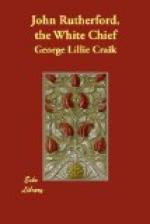Themorangha seems to have been particularly selected by these priests as a subject for their roguish practices, perhaps by way of revenge for the freedom with which he occasionally expressed himself in regard to their pretensions, when his fears were not excited. A short time before this, one of them had terrified him not a little by telling him that he had seen his ghost during the night, and had been informed, by the atua, that if he went to a certain place to which he was then about to proceed, he would die in a few days. He soon, however, got so far the better of his fears as, notwithstanding this alarming intimation, to venture to accompany Marsden to the forbidden district; and he expressed his feelings of contempt for the sacred order in no measured terms, when he found that at the expiration of the predicted period he was still alive.
He said that there were too many priests at New Zealand, and that they “tabooed” and prayed the people to death. Others, as well as the priests, however, are supposed sometimes to have the power of witchcraft.
Two of the missionaries, when one day about to land at a place a short distance from the settlement, were alarmed by nearly running the boat’s head on three human bodies, which lay close together by the water’s edge among some rushes; and upon inquiry they were informed that they were the bodies of three slaves who had been killed that morning for makootooing a chief, i.e. betwitching or praying evil prayers against him, which had caused his death.[BU]
A common method which the priests use of bewitching those whom they mean to destroy, is to curse them, which is universally believed to have a fatal effect. The curse seems usually to be uttered in the shape of a yell or song, so that the process is literally a species of incantation. Bishop Newton, in his commentary on the scriptural account of Balaam being sent for to curse the Israelites, says, “It was a superstitious ceremony in use among the heathens, to devote their enemies to destruction at the beginning of their wars; as if the gods would enter into their passions, and were as unjust and partial as themselves.”
The demeanour of most of the New Zealand priests is something so entirely different from that observed by the ministers of religion in civilized countries that it is not surprising Rutherford should have failed to recognise them as belonging to that order.
Thus, we read of a priest who speaks of having killed, not by enchantment, but in the usual way, with his own hands, both a woman who had gone on board a ship contrary to his orders, and a man who had stolen some potatoes.




